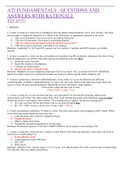Exam (elaborations)
ATI FUNDAMENTALS - QUESTIONS AND ANSWERS WITH RATIONALE TTT 67777
- Course
- Institution
ATI FUNDAMENTALS - QUESTIONS AND ANSWERS WITH RATIONALE TTT 67777 1. MISSING 2. A nurse is caring for a client who is scheduled to have his alanine aminotransferase (ALT) level checked. The client asks the nurse to explain the laboratory test. Which of the following is an appropriate resp...
[Show more]



